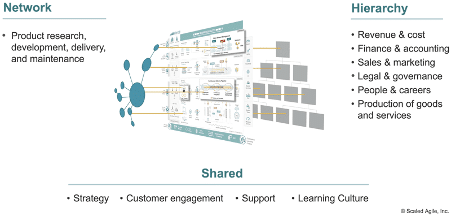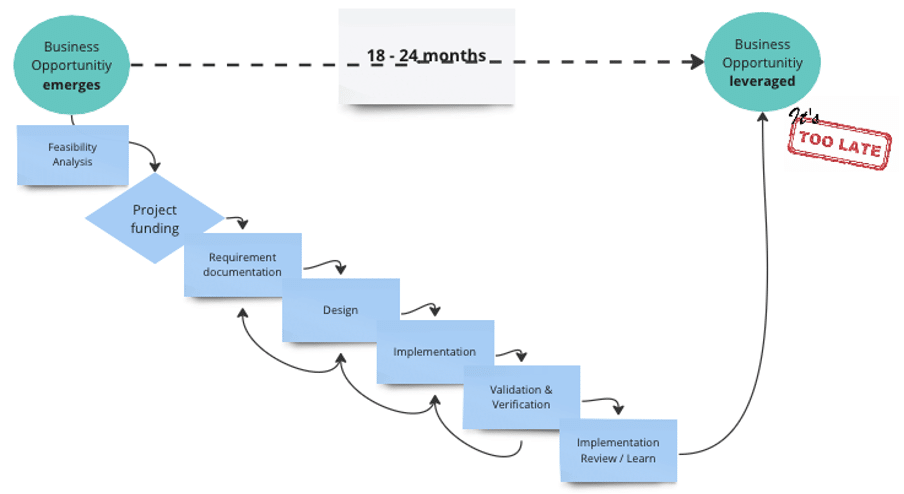We’re in digital era
In an interconnected, real-time environment, every industry is a tech-enabled industry, and every firm is, at least in part, a software corporation. Those who develop will prosper, combining the agility of startups and networked businesses with the hierarchy of established enterprises. The underlying assumptions of the Lean enterprise questions many aspects of traditional management philosophy. Slow adaptation, however, is not an option given the global rate of technology growth. The “transformation” story hasn’t changed, but the market has—the urgency is stronger today than it has ever been.
Change is driven by technology. It also permits the organizational characteristics and procedures that allow for quick adaptability to change. And, just as Agile has revolutionized software development, Scaled Agile has the potential to alter the way a whole business provides customer value. But only if its leaders commit to investing in fundamental transformation.
The tipping point
If this improvement was so simple, every organization would do it and do it effectively. The fact is that meaningful change is frequently the outcome of a forcing function or a tipping point.
Typically, one of two things occurs:
- Burning platform
- Proactive leadership
Business agility eclipse IT; it’s about transforming the whole business.
What began in software development is expanding to encompass the entire enterprise—changing how people work and how every aspect of the business runs.
Business Agility is the ability to compete and thrive in the digital age by quickly responding to market demands and emerging opportunities with innovative and digitally-enabled business solutions.
Every organization would have started with few people together to address specific customer problem / market demand. These are entrepreneurial network people from Product development, research, delivery, support, and maintenance who helped to optimize for speed and adaptability. As organization grows over the period, concentration starts on efficiency and stability which is the organizational hierarchy of HR, Finance, Legal, Sales and Marketing, etc.
Network focused on customer and new business opportunities.
With Business Agility, the hierarchical system benefit and stability are complimented by the speed and innovation of entrepreneurial network.
SAFe implement the network via ‘Value stream’ and supports the hierarchy to balance the system.

Business Agility Value Stream upbeats Traditional method of IT project development. Here is a comparison.
Traditional IT project development is too sluggish to capitalize on business opportunities. Normally, it takes 18-24 months until it leverages.

Delay in budget approval, upfront design, and multi-months to year-long development cycle results in delayed technical and customer feedback. At last, the Implementation review is kind of blame game than brings positive learnings and energy. In traditional method, it’s difficult to understand and adapt customer needs and quickly deliver a solution.
Introducing the Business Agility Value Stream
Instead, a quick cycle of sensing and responding is required to help the enterprise navigate the unknowns and arrive at a preferred solution before opportunity pass by. It is also explicitly designed to foster learning culture and focused on business outcomes. By implementing SAFe, businesses gain the Lean, Agile, and DevOps capabilities which are vital for incremental delivery at scale. Although these capabilities are critical, true business agility necessitates the cultivation and acceleration of flow throughout the Business Agility Value Stream, from detecting an emerging opportunity to delivering the right solution.
- Opportunities are sensed via market research, customer feedback, etc.
- Initiatives (starting with MVP) are funded via OPEX than traditional CAPEX based multi-year project funding.
- Agile Teams and Agile Release Trains are created around the value whereas in traditional project people are assigned to certain projects.
- Customers are connected in the development journey via Customer Centricity and Design Thinking whereas they are involved only during Initial and final phase of projects.
- Teams / ARTs deliver value (during and after MVP) iteratively and incrementally following Lean-Agile practices which creates the transparency to stakeholders. In turn this helps to adjust the scope / features what is being planned in upcoming Increments.
- MVP result leads to decide on further development and enables on investment milestone which is a critical in Portfolio Management.
- DevOps practices optimize a Continuous Delivery Pipeline which ensures a stable flow of Value and the ability to Release on-demand to meet the needs of customers and businesses. This includes customer exploration as well.
- Business Agility Value Stream is an example of continuous learning and innovation. Additionally, it provides learning opportunities via Inspect & Adapt event of every level of SAFe.
- Lean-Agile Leadership not only support and enables Business Agility Value Stream, but also lead the change.
A mindset shift is essential to achieve business agility. Comprehensive solutions are required for systemic problems, and facing new challenges needs new ways of thinking. Course correction, according to conventional wisdom, is an admitting of error. When change is persistent, however, frequent course correction is a sign of competitive advantage.
A organisation that has attained business agility operates more like a living creature than a machine. In adverse situations, machines seize or break down; organisms adapt. The later expands through increasing scale and complexity, both of which must be controlled. The former develops by modifying itself to perform more effectively in a changing environment. In the company-as-organism paradigm, less emphasis is placed on top-down hierarchy and more emphasis is placed on inside-outside symbiosis. Sense-and-respond replaces command-and-control. There is no waste. There is no pause.
Measuring the Business Agility Value Stream
SAFe provides three measurement domains, suitable for measuring and improving value stream
- Flow metrics help determine how fast the Value Stream creates and delivers value.
- Outcome metrics ensures to understand the delivered value.
- Competency measures evaluate Org. proficiency on Business Agility & Individual competency assessment.
One of our SAFe Change Agents enable your ART and setup these metrics;
Further details and Scaled Agile adaptation techniques will be in upcoming blog. Until then stay tuned.